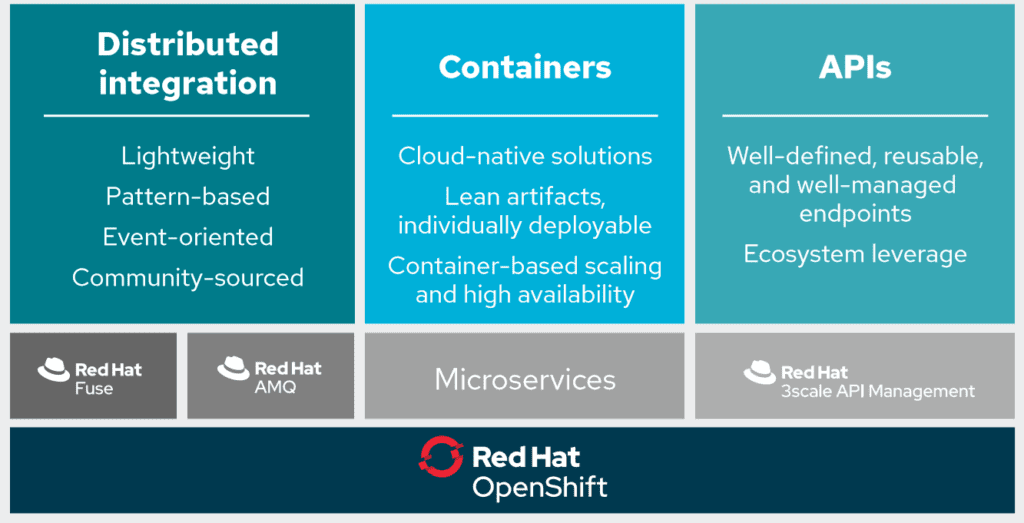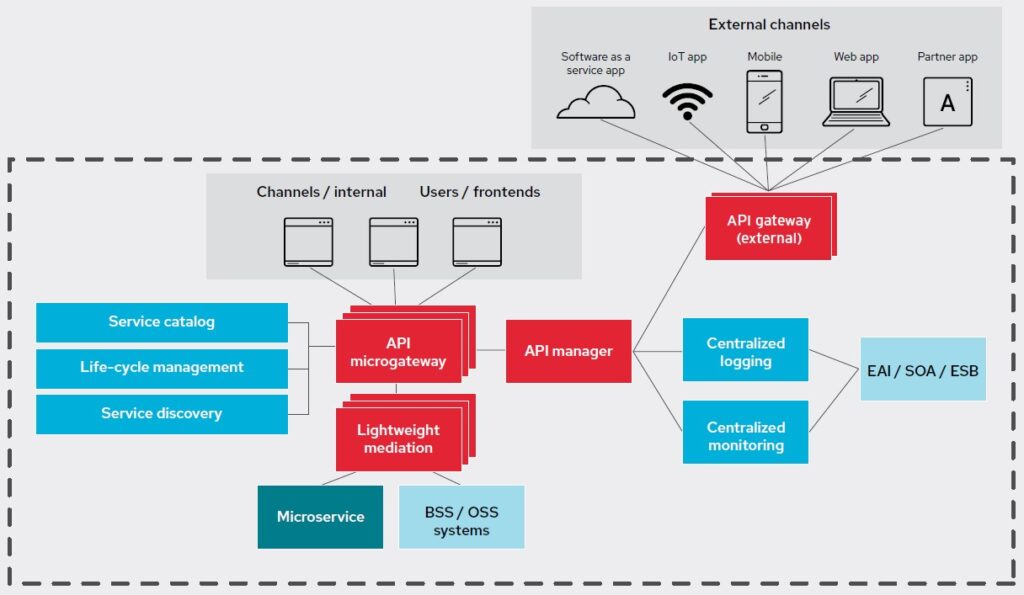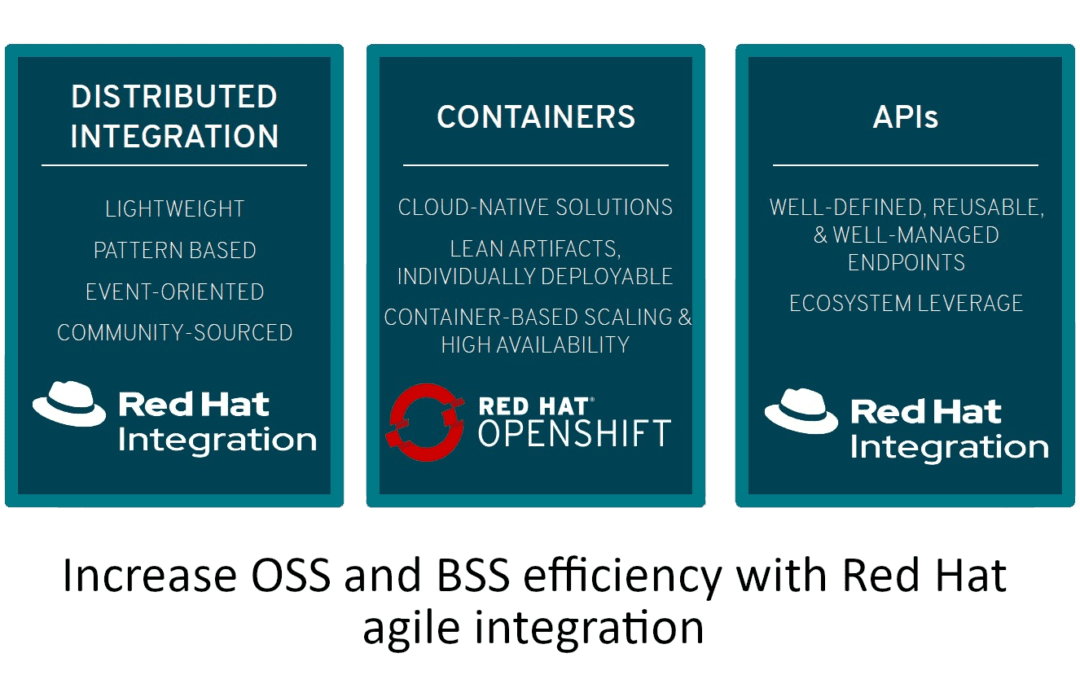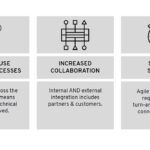Disparate operations support systems (OSS) and business support systems (BSS) lack scalability and limit the value of network and application data. IT teams need federated access to legacy systems and data, while developers and partners need secure, easy access to systems.
An application programming interface (API)-centric approach to integration, secured via API management, addresses these issues for modern, containerized technology and application adoption. Exposing data and functionality using APIs supports reuse and modernization of legacy applications and systems, increases agility and scalability of internal and partner OSS and BSS systems, and reduces maintenance costs.
Challenges of enterprise integration
Integrating internal, vendor, and partner OSS and BSS presents multiple challenges, including:
- Integrating and consolidating ESBs to expose integrated services to customers and partners.
- Keeping pace with integrations of the latest cloud and as-a-Service offerings.
- Addressing the multitude and diversity of channels.
- Consolidating contractor-built interfaces with different authentication mechanisms, limited documentation, and lack of access control.
- Maintaining IT devices that were acquired from other vendors. Teams often have limited knowledge of these devices, particularly when the vendors no longer exist.
Mitigating excessive risk and cost of redesigning or changing existing applications. Many service providers need to standardize management and security across applications while keeping legacy applications untouched.
Benefits of API-centric integration
A fine-grained and modular system design, in which all systems interact via well-defined APIs, offers a range of key benefits:
- Avoids central bottlenecks with distributed integration based on smart endpoints
- Reuse of well-defined interfaces (APIs) across modularized systems
- Scales on demand
- Provides services dynamically and API discovery
- Provides APIs via self-service developer portals
- Centralizes API catalogue and documentation
- Exposes APIs internally and externally to address different API consumer segments with different API policies
- Integrates with single sign-on (SSO) or identity provider solutions
- Implements consolidated, consistent, and controlled security and access model
Service provider success with Red Hat agile integration
Red Hat’s agile integration solution addresses integration challenges and provides the previously described benefits via APIs and API management. Agile methods and practices are combined with specific technologies to produce a flexible, adaptive, and reusable platform for rapid application and data integration, as well as integration of OSS and BSS, with legacy systems.
This agile integration solution outlines three pillars: distributed, containerized, and API-based integration. These three pillars translate into concrete capabilities for communications service providers:
- Distributed integration increases communications service provider flexibility
- Containers increase scalability
- Managed APIs increase reusability
The agile integration solution from Red Hat unites legacy systems, OSS and BSS, and network systems with internal and external end-user applications. Components of this solution are included in all areas of a typical telecommunications stack.

Figure 1: Red Hat agile integration solution delivered through Red Hat products
The agile integration pillars translate into an effective reference architecture for service providers:

Figure 2: Red Hat agile integration reference architecture
This reference architecture is organized into several key functional areas:
- API micro gateways that interface with internal and external channels via shared or dedicated gateways, aggregating thousands of integration points from the back end.
- Lightweight mediation that offers composition, integration, and transformation functionalities.
- Mediation logic can be broken up into standalone integration components that can be distributed, deployed, and scaled on demand.
- The mediation layer is between the gateways and the actual microservices or back ends.
- Microservices that interface with the mediation layer and are separate from legacy architecture — enterprise application integration (EAI) and service-oriented architecture (SOA).
- Functionality that is shared with the legacy architecture for operational purposes, including logging and monitoring, can reside in containers.
- Microservices provide new back-end functionality and can replace specific BSS or OSS functionalities.
- Messaging that can be used to interconnect various components, enabling high-speed, asynchronous communication with reliable delivery.
- Real-time messaging is built for high-throughput streams, fault tolerance, and horizontal scalability and supports geographically distributed data streams and stream processing applications.
- Operations functions that include service discovery, service catalogs, and life-cycle management and automation.
- These functions interface with the API micro gateway to provide shared functionality. Microservices can take advantage of this shared functionality through mediation.
- Business process automation is an optional, compatible capability.
These functions are containerized and certified for Red Hat® OpenShift® Container Platform. OpenShift Container Platform offers a range of hybrid cloud deployments, automated, on-demand scaling, and DevOps benefits. In addition, all agile integration components are API-driven, giving service providers flexibility to extend and integrate within an existing IT landscape.
Red Hat’s agile integration solution is based on open source community development. This model benefits from a large, global community of software developers who continuously contribute to and improve the code. In addition, Red Hat provides quality assurance, 24×7 support, and other benefits for transparency, security, speed, and innovation.
Red Hat, together with Partners like Bintegra, has helped many CSPs worldwide, including managed service providers, implement API centric integration of internal and external systems. Benefits include compliance and security improvements, increased innovation, and reduced costs.




